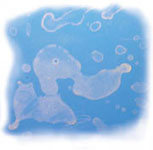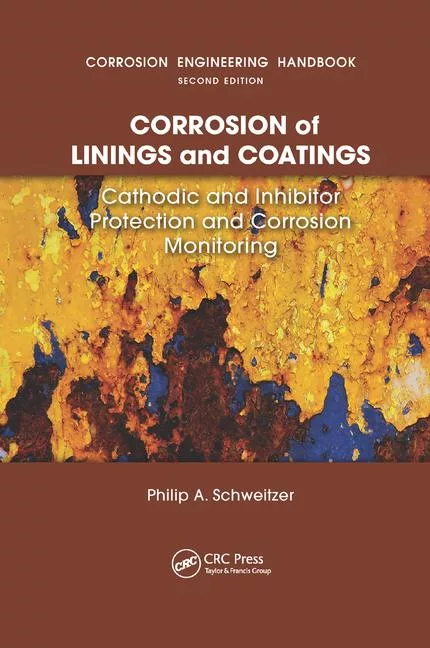Amine Blushing and Blooming of Epoxy Binder Systems in Protective Coatings

When certain epoxy binder systems are applied under low-temperature and/or high-humidity conditions, a side effect of the curing reaction may appear on the coating or flooring surface.1 This side effect can manifest itself as grey cloudiness; gloss reduction; a greasy, waxy layer; or as white crystals or patches. In some instances it may not be visible. However, on contact with high humidity or water, the coated areas can display opaque white marks. The appearance of these marks can occur during cure or even after cure is completed. Although the exudate is, in principle, water soluble it will in most cases not wipe off easily with water, thinners or solvents. Often it can only be removed by dry or wet sanding after the binder has cured completely.
What Are Blushing and Blooming?
Blushing and blooming are two slightly different processes. Blushing, sometimes referred to as water spotting, occurs when moisture condenses on a coating surface during the curing process. Sometimes the moisture originates from within the porous substrate. It manifests itself as white patches or a milky, hazy effect in clear coatings and may cause lack of gloss in pigmented coatings.Blooming, or leaching, is somewhat different from blushing. Blooming occurs when the amount of condensate causes water-soluble compounds to migrate from the body of the coating to the coating surface. When the moisture evaporates, the leached components will appear on the surface as sticky deposits.
Severe blush or bloom will also cause significant surface irregularities, and these defects are serious enough to cause additional light scattering, resulting in an even more whitened appearance.2
Blushing and Blooming Effects
Blush and bloom are surface defects that need to be avoided in an epoxy coating. They affect the coating performance, as they can result in poor gloss retention, discoloration over time (yellowing), poor overcoatability and intercoat adhesion. The most important of these effects is the reduced overcoatability, i.e., insufficient adhesion of a subsequent coating layer to the system due to surface energy modification. In the case of the final layer (topcoat), the mechanical and chemical properties are altered and the visual appearance is worse. A similar phenomenon to the surface effects described above can occur at the coating-substrate interface. If moisture containing dissolved carbon dioxide diffuses out of a porous substrate, e.g., concrete, it can cause incomplete cure at the interface. The incomplete cure affects the final adhesion, which can explain the occasional delamination of epoxy flooring compounds.
Blush and bloom can be removed, but this adds time and cost to the coating/flooring job.
Blushing and Blooming Causes
Blushing, and in some cases, blooming are chemical reactions.3 The chemical component of the epoxy binder system, which causes the blushing or blooming, is in the curing agent. Low-molecular-weight (primary) amines are typically hygroscopic and tend to react with atmospheric carbon dioxide and moisture to form an ammonium carbamate according to the following simplified equation.The greasy layers that can appear on some epoxy binder systems are largely the salts of ammonium (bi-) carbonate. Depending on the type and formulation of the binder system, amine compounds on the surface combine to varying degrees with CO2 (carbon dioxide) and water in humid air to form hydrates of amine carbonate.
The net result of the above side reactions is that amine (active hydrogen) compounds, which were intended to react with the epoxide compounds, are being consumed. As a consequence, not all epoxide groups react with the curing agent, the stoichiometry is compromised and the net result is under curing.
Which Factors Play A Major Role?
There are several factors that play a role in the appearance of blush or bloom. However, two major factors influencing the formation of carbamate or carbonate are the humidity and the reaction rate of the amine with carbon dioxide relative to the epoxy-amine reaction rate.Humidity (Condensation)
The humidity in the air changes continuously and can vary from hour to hour, even within relatively small areas such as within one warehouse. If the substrate temperature falls below the dew point, moisture in the air will condense on the substrate. Upon coating application, air from the spray gun and solvent evaporation can lower the surface temperature of the coating. This effect is accentuated when very fast-drying solvents or an unbalanced solvent mixture is used. The condensed moisture will cause the blushing reaction with the amine compounds.
It is generally accepted in the coatings industry that the minimum surface temperature should normally be at least 3 °C above the dew point before painting. An exception to this is offered by coatings that are specifically designed to be "moisture tolerant".
Blooming or leaching can occur in systems containing water-soluble ingredients. This may include curing agents and additives that are components of solvent- or water-based coatings. Upon exposure to high humidity, components can migrate (leach) to the surface, dissolve in the moisture and leave a shiny or oily-looking deposit. If still liquid, the deposit can typically be washed off with soap and water. However, if the blooming is too severe and saturates the surface before it is thoroughly dried, the result can be discoloration, uneven gloss, drips, runs and even destruction of the binder.
Reaction Kinetics (Rate of Cure)
Amine blush and bloom relate to the reaction of an amine curing agent with moisture and/or carbon dioxide in the air. The amine in question should, in fact, react with the epoxy resin rather than with moisture or carbon dioxide. It is obvious that blush or bloom may be intensified when the rate of the epoxy-amine reaction is retarded.
Temperature
As the temperature decreases, the reaction rate of the amine and epoxy resin is significantly decreased. As a rule of thumb, for every 10 °C reduction in curing temperature the reaction rate will be reduced by a factor of approximately two. The reduction in the cure rate of the epoxy-amine reaction provides the (primary) amines more time to migrate to the surface and undergo additional competing reactions. If, during this period, the environment is damp and cold, the reaction of the amine with CO2 and water is favored, resulting in the formation of blush and bloom.
Curing Agent Type
Another important factor that plays a role in whether blushing or blooming might occur is the type of curing agent. The propensity for blushing or blooming to occur is related directly to the structure of the amine. Low-molecular-weight (cyclo) aliphatic amines, typically used in combination with epoxy resins, are mostly hygroscopic and have a high vapor pressure. These types of products are very susceptible to blushing or blooming. Aliphatic amines are mainly used as raw materials to prepare "advanced" curing agents or in heat cure applications, but they are also used in room-temperature applications where appearance is not so important. An example of such an application would be grouting compounds (mortars) for anchoring heavy machinery. In priming/sealing applications aliphatic amine curing agents may also be used. Although the initial coating will be affected, the application of a subsequent layer in due time might overcome the problem of blushing (see the section on Repair).
In order to eliminate the formation of blush or bloom, a wide range of modified amine curing agents has been developed. The two major categories are epoxy-amine adduct hardeners and a special class of adduct hardeners called Mannich-bases.
The epoxy-amine adduct curing agents are the largest category of products designed to have a reduced tendency to blush. Epoxy-amine adducts are reaction products of liquid epoxy resin with an excess of primary amine. Although epoxy-amine adducts still contain a large excess of free amine, they are less hygroscopic and have a lower vapor pressure compared to the neat amines. Epoxy-amine adducts are less sensitive to blush formation and, as a result, are better suited for coatings/floorings, which cure under high humidity/low temperature. A disadvantage of epoxy-amine adducts is their relatively high viscosity. In order to reduce the viscosity, epoxy-amine adducts are often modified with solvents or plasticizers, such as benzyl alcohol.
Mannich-base curing agents are adduct-type hardeners formed by the condensation of (aliphatic) amines, phenol (derivatives) and formaldehyde. The phenolic hydroxyl group present in these types of molecules has an accelerating effect on the epoxy-amine reaction rate. Moreover, Mannich-bases show better compatibility with liquid epoxy resins than unmodified alkylene amines, as well as reduced blush/bloom tendency and improved early water spot resistance. Special grades of Mannich-bases are products using Cardanol, a major constituent of cashew nut shell liquid, as the phenol component. These types of products, often referred to as phenalkamines, are reference materials in low-temperature, high-humidity cure applications.
Accelerators
These products increase the epoxy-amine reaction rate and subsequently reduce the possibility of the undesired blushing or blooming reactions. Controlled use of the amount and type of accelerator ensures minimal impact on the cured binder performance. Although there are numerous products capable of accelerating epoxy-amine reactions, the most commonly used are: tertiary amines (e.g. DMP-30 = 2,4,6-tris-[dimethylaminomethyl]-phenol), phenol derivatives (e.g., nonylphenol), alcohols (e.g., benzyl alcohol) or acids (e.g., salicylic acid). Be aware that adding accelerator will significantly reduce the pot life of the binder system.
Resin Type
Bloom or blush is less likely to be formed in systems that have a fast epoxy-amine cure rate. The epoxy-amine reaction rate is not only determined by the reactivity of the hardener (amine) but also by the reactivity of epoxy resin.
In order to reduce blush/bloom, epoxy resin components that reduce the reactivity should be avoided. For instance, it is well known that aliphatic mono-functional reactive diluents, frequently used in flooring applications, are low in reactivity. An example of an epoxy resin containing such reactive diluent would be, for instance, D.E.R.* 324 epoxy resin. Reduction of the amount (D.E.R. 325 epoxy resin), or complete elimination (D.E.R. 331 epoxy resin), of this reactive diluent from the binder formulation will enhance the overall epoxy-amine reactivity.
Prevention
The majority of epoxy coating systems will tolerate a certain amount of humidity without being affected. In order to reduce the risk of blushing or blooming some guidelines are suggested below.To promote the epoxy-amine reaction rather than carbamate/carbonate formation, the use of industrial dehumidifiers or heating systems (hot-air blowers) might be considered in confined spaces. Note that gas-burning engines (fork-lift trucks, etc.) as well as direct-fired gas or kerosene heaters ("salamanders") will considerably increase the carbon dioxide content in the air, which is typically around 350-1500 ppm. Moreover, such direct-fired heaters also produce significant amounts of water vapor.
Most coating systems are sensitive to very high levels of humidity and should not be applied when moisture levels in the air are too high. Typically, for standard epoxy binder systems, a relative humidity of 85% at 21 °C or 75% at 10 °C should not be exceeded. Again, in confined spaces, the use of industrial dehumidifiers and/or hot air-blowers may assist in creating correct curing conditions.
The substrate temperature has to be at least 3 °C (5 °C is better) above the dew point before a flooring or coating can be applied. Condensate on the substrate or coating will otherwise result in blush or bloom. Note that, for spray application, special care has to be employed because fast solvent evaporation can additionally reduce the coating temperature to below the dew point. Consider also the temperature drop in the late afternoon or early evening to avoid the formation of "shadow areas."
Before coating a mineral substrate, an assessment of the moisture content in the substrate is essential. For concrete floors the residual moisture content should typically not exceed 4% for regular epoxy binder systems. Special epoxy binder systems are available for humid or "green" concrete allowing higher moisture content.
In case the curing conditions are just inside the limits, but it is thought that the chances of carbamate/carbonate formation are still (too) high, an additional precaution can be taken. Once the curing agent and resin component have been mixed together, the polymerization reaction starts. The further the polymerization reaction has advanced, the lower the chances of a reaction between the amine, carbon dioxide and moisture in the surrounding air. Thorough mixing of the individual components and then leaving the binder to "rest" in the mixing container before application will accomplish this. The pre-reaction time, often referred to as the induction time, will react away most of the free amine (typically the most reactive) and improve the compatibility between the resin component and the curing agent. Care has to be taken that the reaction does not advance too far; sufficient time should remain for the application of the whole batch.
Repair
If, after all the prevention and precautions mentioned above, there are still signs of blush or bloom, then there is still a chance to "rescue" the coating before more intensive repair is required.One of the first measures to employ upon observing the formation of haze in or on the coating is to apply heat to the affected area. Note that heat should not be applied directly to the coating. Under non-controlled conditions (outside) this might be more difficult to do than in confined spaces, especially given the limited time available.
Epoxy resin-based sealers/primers applied on mineral substrates, such as concrete, are prone to blushing, as moisture from the porous surface can be absorbed immediately prior to curing. The primer can become milky as a result of such moisture entrapment. Sometimes this phenomenon can be "repaired" by immediately applying an additional coat of the same solvent-containing product or by saturating the coating with solvent. The new layer of solventborne coating or the neat solvent will usually soften/plasticize the coating sufficiently to allow the entrapped moisture to be released and the microscopic water droplets causing the white haze to disappear.
In case a coating has been affected, it can still be possible to apply a second, filled layer without grinding. The filled layer must be applied, however, before the first affected coating has been allowed to thoroughly cure. The new epoxy layer will "dissolve" the top layer of the "old" coat and fuse "chemically." Naturally it must be ensured that the new coat will not also be susceptible to blushing or blooming. If the coating has completely dried, minor blushing may be corrected by compounding or polishing. Repeated washing operations may, in some cases, bring improvement. Whereas some applicators use water, others report success with a citric acid solution or dilute vinegar.
Severe blushing, however, will require sanding and refinishing. Grinding the top surface of a coating produces a lot of dust, which will require adequate worker protection. In some other cases the coating must be removed entirely before recoating. This has a big impact on the time and amount of labor needed to complete a painting job, making the application much more expensive than anticipated.
References
1 Croll, S.G. Atmospheric gasses and the hardening of an amine cured epoxy coating. J. Ctgs. Tech. 1980, 51, No 664, 65-69.2 Lucas, P.A.; Clark, P.A.; Haney, R.J.; Kittek, M.R. Investigation of waterspot and blush resistance of epoxy industrial floors. Air Products and Chemicals Inc., presented at the American Concrete Institute Conference, 1997, Seattle, WA.
3 Burton, B.L. Amine-blushing problems? No sweat! Huntsman Corp., presented at the Epoxy Resin Formulators' meeting, The Society of the Plastics Industry, fall 2001.
References to "Dow" or the "Company" mean The Dow Chemical Company and its consolidated subsidiaries unless otherwise expressly noted.
For further information, visit Dow's website at www.dow.com.
Looking for a reprint of this article?
From high-res PDFs to custom plaques, order your copy today!









